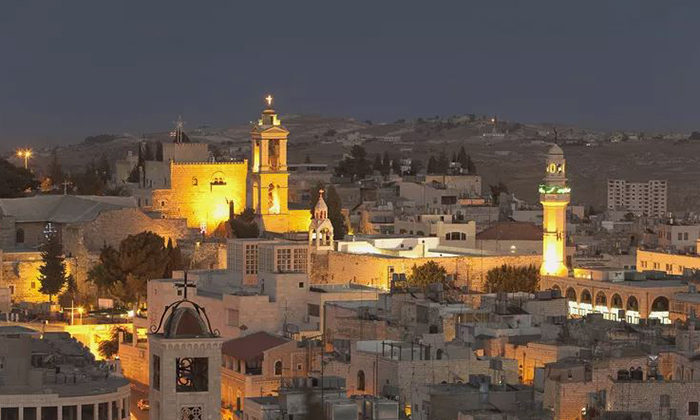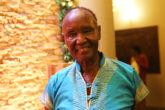
XYZ PICTURES/Getty Images
The city of Bethlehem, located about six miles southwest of Jerusalem, is the birthplace of our Savior Jesus Christ. Meaning “house of bread,” Bethlehem was also the renowned City of David. It was there in young David’s hometown that the prophet Samuel anointed him to be king over Israel (1 Samuel 16:1-13).
Birthplace of Jesus Christ
In Micah 5, the prophet foretold that Messiah would come from the small and seemingly insignificant town of Bethlehem:
Micah 5:2–5
“But you, O Bethlehem Ephrathah, are only a small village among all the people of Judah. Yet a ruler of Israel will come from you, one whose origins are from the distant past … And he will stand to lead his flock with the LORD’s strength, in the majesty of the name of the LORD his God. Then his people will live there undisturbed, for he will be highly honored around the world. And he will be the source of peace…” (NLT)
Bethlehem in the Old Testament
In the Old Testament, Bethlehem was an early Canaanite settlement connected with the patriarchs. Situated along an ancient caravan route, Bethlehem has harbored a melting pot of peoples and cultures since its beginning. The geography of the region is mountainous, sitting about 2,600 feet above the Mediterranean Sea.
In times past, Bethlehem was also called Ephrathah or Bethlehem-Judah to distinguish it from a second Bethlehem located in the Zebulunite territory. It was first mentioned in Genesis 35:19, as the burial site of Rachel, Jacob‘s favored wife.
Members of Caleb’s family settled in Bethlehem, including Caleb’s son Salma who was called the “founder” or “father” of Bethlehem in 1 Chronicles 2:51.
The Levite priest who served in the house of Micah was from Bethlehem:
Judges 17:7–12
“One day a young Levite, who had been living in Bethlehem in Judah, arrived in that area. He had left Bethlehem in search of another place to live, and as he traveled, he came to the hill country of Ephraim. He happened to stop at Micah’s house as he was traveling through…So Micah installed the Levite as his personal priest, and he lived in Micah’s house.” (NLT)
The Levite of Ephraim brought home a concubine from Bethlehem:
Judges 19:1
“Now in those days Israel had no king. There was a man from the tribe of Levi living in a remote area of the hill country of Ephraim. One day he brought home a woman from Bethlehem in Judah to be his concubine.” (NLT)
The poignant story of Naomi, Ruth, and Boaz from the book of Ruth is set primarily around the town of Bethlehem. King David, the great-grandson of Ruth and Boaz was born and raised in Bethlehem, and there David’s mighty men lived. Bethlehem eventually came to be called the City of David as the symbol of his great dynasty. It grew into an important, strategic, and fortified city under King Rehoboam.
Bethlehem is also noted in connection with the Babylonian exile (Jeremiah 41:17, Ezra 2:21), as some of the Jews returning from captivity stayed near Bethlehem on their way to Egypt.
Bethlehem in the New Testament
By the time of Jesus’ birth, Bethlehem had declined in significance to a small village. Three gospel accounts (Matthew 2:1–12, Luke 2:4–20, and John 7:42) report that Jesus was born in the humble town of Bethlehem.
At the time Mary was due to give birth, Caesar Augustus decreed that a census be taken. Every person in the Roman world had to go to his own town to register. Joseph, being of the line of David, was required to go to Bethlehem to register with Mary. While in Bethlehem, Mary gave birth to Jesus. Likely due to the census, the inn was too crowded, and Mary gave birth in a crude stable.
Shepherds and later wise men came to Bethlehem to worship the Christ-child. King Herod, who was ruler in Judea, plotted to kill the baby-king by ordering the slaughter of all male children two years old and younger in Bethlehem and surrounding areas (Matthew 2:16–18).
Present Day Bethlehem
Today, approximately 60,000 people live in and around the broader Bethlehem area. The population is divided primarily between Muslims and Christians, the Christians being predominately Orthodox.
Under control of the Palestinian National Authority since 1995, Bethlehem city has experienced chaotic growth and a constant flow of tourism. It is home to one of the most sacred Christian sites in the world. Built by Constantine the Great (circa 330 A.D.), the Church of the Nativity still stands over a cave believed to be the very spot where Jesus was born. The place of the manger is marked by a 14-pointed silver star, called the star of Bethlehem.
The original Church of the Nativity structure was partially destroyed by the Samaritans in 529 A.D. and then rebuilt by the Byzantine Roman emperor Justinian. It is one of the oldest surviving Christian churches in existence today.

